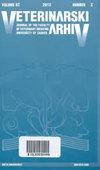The effects of pre- and postnatal exposure to perfluorooctanoic acid on the expression of major reproduction-related genes in the mouse hypothalamus and gonads
IF 0.3
4区 农林科学
Q4 VETERINARY SCIENCES
引用次数: 0
Abstract
Perfluorooctanoic acid (PFOA), a ubiquitous environmental pollutant reported to be an endocrine disruptor, is used in many industrial and consumer products. Although the adverse effects of PFOA on the reproductive health of animals and humans have been widely reported, most studies have focused on assessing the anatomical features and conventional histology of adult gonads. Therefore, the molecular mechanisms activated in the hypothalamus and gonads following PFOA exposure during the pre- and postnatal periods are not clear. This study used a mouse model to evaluate the effects of PFOA exposure on the alteration of molecular mechanisms in the hypothalamus and gonads during the prenatal and postpartum periods. Changes in gene and protein expression following PFOA exposure were evaluated by quantitative polymerase chain reaction and Western blotting, respectively. Kisspeptin 1 and gonadotropin-releasing hormone expression in the hypothalamus of female and male mouse pups was significantly decreased. Additionally, Cyp17a1 expression was upregulated in male offspring testes, while Cyp17a1 and Cyp19a1 expression was downregulated in female offspring ovaries. Changes at the molecular level due to PFOA exposure in the early stages of development did not show sex-related differences in the hypothalamus; however, such differences were confirmed in the gonads. These results could be used as basic data to study the molecular mechanisms underlying the reproductive dysfunction caused by PFOA exposure in the early stages of embryonic development.产前和产后全氟辛酸暴露对小鼠下丘脑和性腺主要生殖相关基因表达的影响
全氟辛酸(PFOA)是一种普遍存在的环境污染物,据报道是一种内分泌干扰物,用于许多工业和消费品。尽管PFOA对动物和人类生殖健康的不利影响已被广泛报道,但大多数研究都集中在评估成年性腺的解剖特征和常规组织学上。因此,在产前和产后暴露于PFOA后,下丘脑和性腺中激活的分子机制尚不清楚。本研究采用小鼠模型研究了PFOA暴露对产前和产后下丘脑和性腺分子机制改变的影响。分别采用定量聚合酶链反应和Western blotting检测PFOA暴露后基因和蛋白表达的变化。雌性和雄性小鼠下丘脑Kisspeptin 1和促性腺激素释放激素的表达显著降低。此外,Cyp17a1在雄性后代睾丸中表达上调,而Cyp17a1和Cyp19a1在雌性后代卵巢中表达下调。在发育早期暴露于PFOA导致的分子水平变化在下丘脑中没有显示出与性别相关的差异;然而,这种差异在性腺中得到了证实。这些结果可为研究胚胎发育早期PFOA暴露导致生殖功能障碍的分子机制提供基础数据。
本文章由计算机程序翻译,如有差异,请以英文原文为准。
求助全文
约1分钟内获得全文
求助全文
来源期刊

Veterinarski Arhiv
VETERINARY SCIENCES-
CiteScore
0.80
自引率
20.00%
发文量
22
审稿时长
6-12 weeks
期刊介绍:
The journal Veterinarski arhiv (Vet. arhiv) publishes original scientific papers, case reports, short communications, review papers and book reviews. Occasionally, in supplemental issues, it publishes papers of relevant conferences. The scope of the journal includes all fields of veterinary and animal sciences. Veterinarski arhiv is published by the Faculty of Veterinary Medicine University of Zagreb, six times a year, as an open access, peer-reviewed, international scientific journal. Only unpublished manuscripts may be accepted for the review process. All papers must be written in English and submitted via the Journal''s online submission system (COMET). The content of the Journal is available free of charge and there are no publication charges.
 求助内容:
求助内容: 应助结果提醒方式:
应助结果提醒方式:


